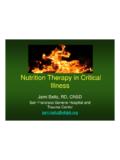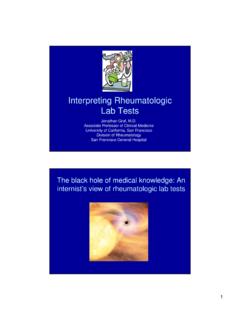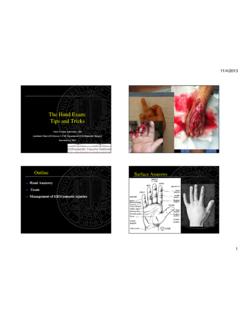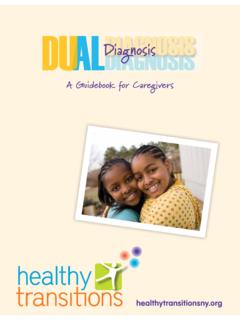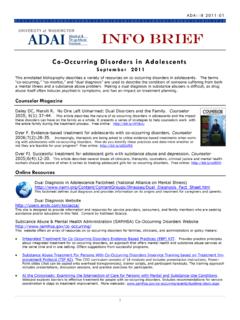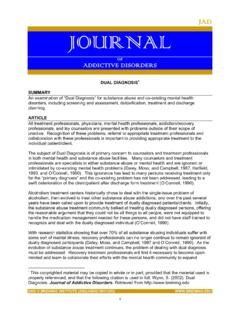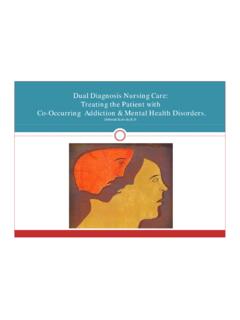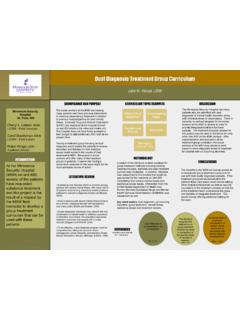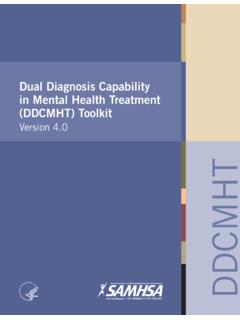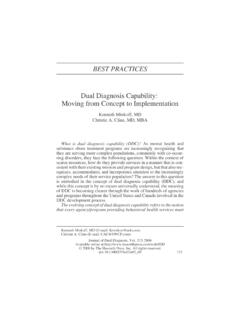Transcription of Dual Diagnosis: Assessment, Diagnosis, and Treatment
1 dual Diagnosis: assessment , diagnosis , and TreatmentMichael S. Marcin, MD, MSCRA ssociate Clinical Professor, UCSFA ssistant Medical Director, AIP LPPIM arch 4, 20162 Financial Disclosure:I have nothing to : Patients, families and caregivers Andrew Booty Gerri Collins-Bride Jim Bourgeois Clarissa Kripke Gaelen Lombard Matthew State My Colleagues at GGRC and ARC4 Comments about Presentation We have a discussion panel following this, which is a great time to ask more involved questions. Please ask if a slide needs clarification. Most of the data for the many studies presented are based in the DSM-IV not the DSM-5. Nearly all of this presentation is based on other people s hard work. Please see the slide-by-slide Reference Handout provided today. Readability of slides was my main goal for this Outline Working Assumptions What is dual diagnosis ?
2 Problem Behaviors vs. Psychiatric Disabilities/Disorders Why are We Talking about dual diagnosis ? assessment Tools Somatic Treatment Options6 Presentation Outline Working Assumptions What is dual diagnosis ? Problem Behaviors vs. Psychiatric Disabilities/Disorders Why are We Talking about dual diagnosis ? assessment Tools Somatic Treatment Options7 Working Assumptions Individuals with dual diagnosis are INDIVIDUALS Seeing persons with DD as anything other than entire persons leads us astray Individuals, Providers and Caregivers are doing the best they can on a daily basis Looking at available, high quality research data provides an anchor in decision making There is a lack of this data across the spectrum of persons with ID as well as persons with PD and especially for those with both, DD. Yet, progress is being made8 Presentation Outline Working Assumptions What is dual diagnosis ?
3 Problem Behaviors vs. Psychiatric Disabilities/Disorders Why are We Talking about dual diagnosis ? assessment Tools Somatic Treatment Options9 Defining dual diagnosis (? + ? = DD) Intellectual disability in DSM-5 involves mental impairments that affect adaptive functioning in three domains impacting completion of everyday tasks: Conceptual domain: skills in language, reading, writing, math, reasoning, knowledge, and memory. Social domain: empathy, social judgment, interpersonal communication skills, the ability to make and retain friendships, and similar capacities. Practical domain: self-management in areas such as personal care, job responsibilities, money management, recreation, and organizing school and work tasks. dual diagnosis (? + ? = DD) Psychiatric Disability/Disorder: Clinically significant disturbance in cognitive, emotional regulation, and behavior that represents a disturbance in mental functioning that leads to struggles with work, school, family or other social arenas.
4 (DSM 5, American Psychiatric Association, 2013, ) Neurodevelopmental Disorders: Intellectual Disabilities + Communication Disorders + Autism Spectrum Disorder + AD/HD + Specific Learning Disorder + Motor Disorders + Other Neurodevelopmental Disorders Basically: PD= All DSM 5 diagnoses some Neurodevelopmental Disorders but keeping others Now, you know why everyone is so confused11 Defining dual diagnosis (? + ? = DD) " dual diagnosis is a conceptualization of comorbidity in adults with an intellectual disability. Co-morbidity refers to the presence of at least two distinct and separate disabilities or pathologies in the same individual. First utilized in the US during the 1970s, dual diagnosis was used to describe mental health problems in adults with an intellectual disability. The term dual diagnosis specifically refers to coexisting intellectual disability and mental disorder.
5 dual diagnosis = ID +/- Autism + other DSM 5 non-Neurodevelopmental Disorders12 Presentation Outline Working Assumptions What is dual diagnosis ? Problem Behaviors vs. Psychiatric Disabilities/Disorders Why are We Talking about dual diagnosis ? assessment Tools Somatic Treatment Options13 Defining Problem Behaviors AKA Challenging Behaviors (PB/CB) People with intellectual disabilities are at higher risk for developing behavior problems. Studies have reported that 7 15% of individuals with ID who receive services have severe behavior problems. Thus, 85 93% of people with ID do not show severe behavior problems, regardless of what level of their ID. Types of PB/CB are: aggression towards others, temper tantrums, screaming or shouting, and self-injury Several authors have suggested that behavior problems may be indicators of psychiatric disorders in individuals with intellectual disability There is a higher incidence of PD in persons with ID who also have PB/CB compared to those without challenging Problem Behaviors AKA Challenging Behaviors (PB/CB) In individuals with ID, physical aggression was associated with a 50% probability of PD.
6 The presence of PB/CB increased the probability of almost all psychiatric conditions. Several research studies suggest that in persons with ID there is a strong relation between behavior problems and psychiatric disorders in individuals with intellectual disability151617 Other Correlations: Level of ID, Symptoms of PD and PB/CB More symptoms of PD in those with mild and moderate than those classified as severe and profound ID. Those classified as mild/moderate had more symptoms of psychosis and depression than those classified as severe/ profound, while other symptoms of PD were more evenly distributed regardless of classification of ID. Interesting Correlation Between PD and PB/CB: anxiety tantrums mania tantrums, aggression and screaming weakest correlation: self-injurious behavior (SIB) depression aggression, tantrums and screaming in those classified as severe and profound depression tantrums and SIB, mild and moderate ID18 Hypotheses of Link PB/CB may have the same roots that express itself differently sometimes as PD Challenging behavior may be an expression of mental illness Challenging behaviors may occur in an attempt to stop aversive experiences in PD19 Presentation Outline Working Assumptions What is dual diagnosis ?
7 Problem Behaviors vs. Psychiatric Disabilities/Disorders Why are We Talking about dual diagnosis ? assessment Tools Somatic Treatment Options20 Why focus on dual diagnosis ? Average life expectancy of people with ID is around 60 years. But, for those individuals with mild ID free of comorbid PD, their lives are as long as neurotypicalindividuals. Many studies show that for children and adolescents with ID between 30 and 50% have comorbid PD with a relative risk of having PD with ID of The mental well-being of parents of children with ID is more affected by their children s severity of PD than that of the severity of ID Adults with ID experience comorbid PD at higher rates than other adults; point prevalence is approximately 40% with annual incidence at about 8%21 Why focus on dual diagnosis ? The 1995 Welsh Health Survey found that persons with ID had a higher rate of psychiatric illness ( ) than the general population ( ).
8 People with ID disproportionately contribute to total psychiatric morbidity. Emerson and Hatton in 2007 estimated that the 3% of British children with ID account for 14% of total child and adolescent psychiatric morbidity Psychosocial masking Cognitive disintegration 222324 Examples of Specific Psychiatric Disabilities/Disorders Rates 2005 Australian Study looking at the Disability, Ageing and Carers Survey, 1998 comprising data on 42,664 adults living at home or in care facilities. The prevalence of ID was Rates for disabling comorbid PD were: psychosis, 8% depression, and 14% had an anxiety disorder. (E9) Two more studies reported a point prevalence of 3% and respectively for schizophrenia compared to in the general population Interestingly, in another study the point prevalence of depressive disorder ranged up to , which is just over a fourth in the general population25 How Does Ageing Affect Those with Intellectual Disability?
9 Londoners with ID who are 65 and older showed PD in 74% of those surveyed. Those with Down s Syndrome have higher rates of dementia. In those 65 years or over, had dementia, which is higher than general population. Down s Syndrome and dementia is associated with more frequent and severe PB/CB Dementia progression in people with Down s Syndrome was demonstrated to be: 45 to 49 years ; 50 54 years ; 55 59 years ; 60 years plus Increased mortality in those with dementia ( ) compared with those without dementia ( ).262728 dual diagnosis in Autism Higher parent and teacher ratings for ADHD, ODD, aggression, anxiety, and depression compared with neurotypical students. Preschoolers through young adults: elevated behavior problems, anxiety, depression, irritability compared to control group. Individuals without ASD but with ID had lower rates of same behaviors when compared with individuals with autism.
10 Hurtig et al. (2009) reported greater anxiety, depression, and attention problems in 43 adolescents with HFA/Asperger s disorder than controls. 29 dual diagnosis in Autism A study of 177 children with autism showed elevated scores: 26% depression, 25% anxiety, 25% ADHD, 16% conduct disorder, and 15% oppositional- defiant disorder. Youth with autism (combining results from two studies): 8-44%for specific phobia, 29% social anxiety disorder 8-37%for OCD, 10% panic disorder, 8% agoraphobia 2-13% for generalized anxiety disorder 28-31% for ADHD, 13% for depression, 12% for separation anxiety disorder, 7-28% for oppositional-defiant disorder, 3% conduct disorder3031323334 Presentation Outline Working Assumptions What is dual diagnosis ? Problem Behaviors vs. Psychiatric Disabilities/Disorders Why are We Talking about dual diagnosis ? assessment Tools Somatic Treatment Options35 What is an Ideal assessment ?



